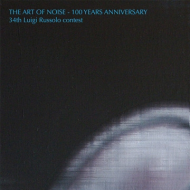![Watercoloured Well - Arsonists Rebirthday Audition [CD]](https://www.steelwork.fr/646-home_default/watercoloured-well-arsonists-rebirthday-audition-cd-.jpg)
This unique collaboration of three Japanese musicians (coming from quite different music background) tends to be the most radical and uncompromising one. It's really hard to explain what it's all about, it's too alien and very far from any rational thought you can imagine. For the unprepared listener, it can be very uneasy and helpless experience, but for me, it explains the very idea of avant garde music in our post modern age.
Hideaki Shimada is a Japanese violinist born in 1962, living on the West coast of Japan, in Kanazawa. In the late 70s he became interested in the European improvised music scene. Since 1980, he has been involved in violin improvisation. In 1985, he started solo project, Agencement, that creates multi-layered violin improvisations and records them on magnetic tape. In the late 80s, he was also doing some collaborations with Merzbow, Toukaseibunshi and other artists on Japanese noise scene. In his live performances, Shimada uses amplified acoustic violin and electronic equipment. Recently, Shimada performs live with various improvised music instrumentalists and plays both acoustic and electric violins. What Shimada gives us intellectually is quality in limited quantity – a maximum result from minimum effort. His solowork has been described as both noise and music, avantgarde and minimalist, nervous and mellow, frantic and still, hectic and calm. During recent 20 years, he released two LPs, "Viosphere" CD (1991) and "Boxe Consonantique" CD (2001) on his own Pico label.
During the 80s, Kiyoshi Mizutani was a member of Merzbow with Masami Akita – the man who’s name is often synonymous with Merzbow. In 1989, Mizutani started solo work and released his first LP "The Same Thing Makes Always Her Laugh". Afterwards, his records were published by Ulcer House, ZSF Produkt, Sounds For Consciousness Rape, Pure, Artware, Kaon, e(r)ostrate, Povertech Industries and Flenix Records. Mizutani's sound is characterized by use of primitive electric feedback and field recordings collected on his own. In his work, main interest is in the existence of the sound materials and how one perceives the material. The perception is included in the whole relation. Soundscape theory is integral to his work, that one catches the sound in social or natural relations. The sound is recognized as a signal, a message, or environment. Perhaps a good example is a bird's song that is both very interesting and tells something. And in many cases, bird songs also recognize our existence. Kiyoshi Mizutani's recent albums are "Bird Songs" (2000, Ground Fault), "Yokosawa-iri" (2002, CMR) and "Scenery Of The Border: Environment And Folklore Of The Tanzawa Mountains" (2005, and/OAR).
Hideaki Shimada: violin, live electronics
Kiyoshi Mizutani: feed back, drumstick
Recorded at Gambetta, Tokyo, on November 18th, 2001
Remix by Kiyoharu Kuwayama, on May 04th, 2008
| 1. | Chimère 1 | 10:20 | [ mp3 sample 128kbps 0:31 493k ] | |
| 2. | Meguro | 10:43 | [ mp3 sample 128kbps 0:32 501k ] | |
| 3. | Chimère 2 | 07:16 | [ mp3 sample 128kbps 0:28 446k ] | |
| 4. | Bicephalous | 10:52 | [ mp3 sample 128kbps 0:33 523k ] | |
| 5. | Equinox Transformations | 18:08 | [ mp3 sample 128kbps 0:57 904k ] |

![Kuwayama/Shimada/Mizutani - Gambetta [CD]](https://www.steelwork.fr/650-medium_default/kuwayama-shimada-mizutani-gambetta-cd-.jpg)
![Kuwayama/Shimada/Mizutani - Gambetta [CD]](https://www.steelwork.fr/650-small_default/kuwayama-shimada-mizutani-gambetta-cd-.jpg)

![Yannick Franck - Hierophany [CD]](https://www.steelwork.fr/848-home_default/yannick-franck-hierophany-cd-.jpg)
![Pbk & Zanstones - Mantis Fog Desert [CD]](https://www.steelwork.fr/648-home_default/pbk-zanstones-mantis-fog-desert-cd-.jpg)
![Tbc - Insecta: The Birth Of Gods [CD]](https://www.steelwork.fr/645-home_default/tbc-insecta-the-birth-of-gods-cd-.jpg)
![Trance - Compiled [CD]](https://www.steelwork.fr/652-home_default/trance-compiled-cd-.jpg)